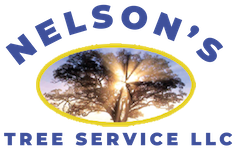FAQ
Have a question?
Don’t see your questions answered here? Get in touch with us today and someone from our team will answer your questions.
Give us a call or contact us today to get started!
Why will Nelson's Tree Service not top my tree?
Topping involves removing all parts of a tree above a certain height, with no consideration for its structure or health. This method is not a viable method of height reduction, but only a temporary and ineffective solution that actually makes a tree more hazardous in the long run.
The destructive effects of tree topping include:
- “Starved” Trees – Topping often removes 50-100 percent of the leaf-bearing crown robbing the tree of food-creating leaves.
- Creation Of Weak Shoots– As a defense mechanism, a tree will quickly grow (up to 20 feet) food-producing shoots that are weak and prone to breaking, resulting in a more hazardous tree.
- Added Stress For The Tree – If a tree does not have enough stored energy, it will not be able to produce the chemicals required to defend the multiple wounds from a disease or insect attack.
- “Sunburned” Trees – The leaves within a tree’s crown absorb sunlight. Without this protection, branches and trunks are exposed to high levels of light and heat, which can burn the tissues beneath the bark.
- Poor Aesthetics – Topping removes the ends of branches often leaving unsightly stubs, and destroying the natural form of the tree. A tree that has been topped can never fully regain its natural form.
- Higher Maintenance Costs – Trees that have been topped will need pruning more often, or may die and need to be removed. Topped trees are potential liabilities and can reduce property value.
Are my trees safe from the possible wrath of Mother Nature (storm damage)?
Heavy rains, wind, and ice damage thousands of trees and communities annually. Recognizing and reducing tree hazards not only increases the safety of your property and that of your neighbors, but also improves the tree’s health and may increase its longevity.
Beware of these potential hazards:
- Cracks in the trunk of major limbs
- Hollow, aged, and decayed trees
- One-sided or significantly leaning trees
- Branches that hang over the house near the roof
- Close proximity of utility lines
Take the following precautions to prevent damage:
- Remove dead, diseased, and damaged limbs
- Consider removing trees with large cavities of decay
- Leaning trees may indicate a root problem, so consider having them inspected
- Branches that are too close or toughing utility lines need to be pruned or removed. If this is needed, report it to your local utility company, DO NOT prune the tree yourself.
When should my trees be pruned?
Most routine pruning to remove weak, diseased, or dead limbs can be accomplished at any time during the year with little effect on the tree. As a rule, growth is maximized and wound closure is fastest if pruning takes place before the spring growth flush. Some trees, such as maples and birches, tend to “bleed” if pruned early in the spring. It may be unsightly, but it is of little consequence to the tree. A few tree diseases, such as oak wilt, can be spread when pruning wounds allow spores access into the tree. Susceptible trees should not be pruned until after the first hard freeze. It also has to stay below freezing for a few days to make sure all the sap is away from the area that would be cut.
How does oak wilt occur?
The oak wilt fungus can move from tree to tree in two ways―it can travel underground through the roots or over land by insect vectors. Locally, most new infections occur as a result of the fungus moving from an infected tree to a nearby healthy tree through a connected root system. The roots of trees in an oak group commonly graft to each other, forming a continuous underground network.
Where does the emerald ash borer come from?
The natural range of the emerald ash borer (Agrilus planipennis) is throughout eastern Russia, northern China, Japan and Korea. Prior to June 2002, it had never been found in North America. We don’t know with certainty how it got here, but most likely, it arrived in ash wood used for stabilizing cargo in ships and for packing and crating heavy consumer goods.
Where has the emerald ash borer been found?
In 2002, the emerald ash borer was thought to affect six counties in southeastern Michigan. Since then, the ability to detect this species has improved substantially and we know a much greater area was infested than initially thought. Now, it has been found in almost every county in Michigan as well as in Indiana, Ohio, Illinois, Pennsylvania, Virginia, West Virginia, Wisconsin, Missouri, Maryland and areas of Canada including Quebec and Ontario. Most of these infestations are not new, but it’s important to watch for signs and symptoms of the emerald ash borer in areas it is not known to be found, as it can be accidentally transported.
What happens to trees infested by the emerald ash borer?
The canopy of an infested tree begins to thin above the trunk and major branches as the borer destroys the water and nutrient-conducting tissues under the bark. Heavily infested trees exhibit canopy die-back, typically starting at the top of the tree. As many as one-third to half of the branches may die in one year, and most of the canopy will have died within two years of the first observation of symptoms. Although difficult to see, adult borers leave D-shaped exit holes roughly ⅛ inch in diameter in the bark upon emerging in June.
